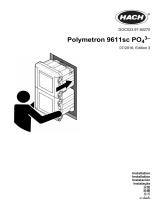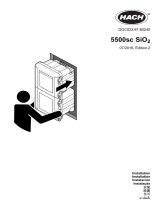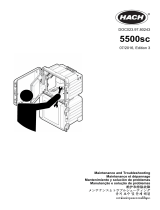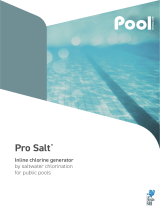La page est en cours de chargement...

DOC026.97.80326
WDMP sc
08/2019, Edition 2
User Manual
Manual del usuario
Manuel de l’utilisateur

Table of Contents
English..............................................................................................................................3
Español.......................................................................................................................... 24
Français......................................................................................................................... 48
2

Table of Contents
1 Specifications on page 3
2 General information on page 4
3 Installation on page 9
4 Startup on page 18
5 Operation on page 19
6 Maintenance on page 19
7 Troubleshooting on page 22
8 Replacement parts and accessories on page 22
Section 1 Specifications
Specifications are subject to change without notice. The specifications that follow are for the junction
box (Table 1) and the WDMP sc panel (Table 2). Refer to the instrument user manuals for the
analyzer, controller, turbidimeter and probe sensor specifications.
Table 1 Junction box
Specification Details
Power requirements 100 to 115/230 VAC, 50/60 Hz
Power consumption 90 VA maximum for CL17 analyzer
24 W maximum for all other electronics
Protection class I
Installation category II
Pollution degree 2
Altitude 2000 m (6562 ft) maximum
Fuse 5 x 20 mm, T 1.0 A, 250 V (2x)
Storage temperature –20 to 60 °C (–4 to 140 °F)
Conduit hub ½ NPT
Communications RS485 Modbus
Humidity Maximum relative humidity 80% for temperatures to 31 °C (88 °F), decreasing linearly to
50% relative humidity at 40 °C (104 °F)
Table 2 WDMP sc panel
Specification Details
Dimensions (W x H x D) 81 x 122 x 30.8 cm (32 x 48 x 12.1 in.)
Weight 54.4 kg (120 lb)
Operating temperature 5 to 40 °C (41 to 104 °F)
Sample flow rate 0.4 to 0.6 L/min
Sample pressure 138 to 862 kPa (20 to 125 psi)
Sample temperature 5 to 40 °C (41 to 104 °F)
Sample inlet connection ½-in. OD tube
Sample waste drain connection ¾-in. ID hose barb
Sample waste drain pressure Ambient, free-flowing (atmospheric)
Pressure sensor Stainless steel (17-4 PH), Input: 7–35 VDC; Output: 4–20 mA, 0–1034 kPa
(0–150 psi)
English 3

Table 2 WDMP sc panel (continued)
Specification Details
Certifications ETL listed to UL and CSA standards
Warranty 1 year
Section 2 General information
In no event will the manufacturer be liable for direct, indirect, special, incidental or consequential
damages resulting from any defect or omission in this manual. The manufacturer reserves the right to
make changes in this manual and the products it describes at any time, without notice or obligation.
Revised editions are found on the manufacturer’s website.
2.1 Safety information
N O T I C E
The manufacturer is not responsible for any damages due to misapplication or misuse of this product including,
without limitation, direct, incidental and consequential damages, and disclaims such damages to the full extent
permitted under applicable law. The user is solely responsible to identify critical application risks and install
appropriate mechanisms to protect processes during a possible equipment malfunction.
Please read this entire manual before unpacking, setting up or operating this equipment. Pay
attention to all danger and caution statements. Failure to do so could result in serious injury to the
operator or damage to the equipment.
Make sure that the protection provided by this equipment is not impaired. Do not use or install this
equipment in any manner other than that specified in this manual.
2.1.1 Use of hazard information
D A N G E R
Indicates a potentially or imminently hazardous situation which, if not avoided, will result in death or serious injury.
W A R N I N G
Indicates a potentially or imminently hazardous situation which, if not avoided, could result in death or serious
injury.
C A U T I O N
Indicates a potentially hazardous situation that may result in minor or moderate injury.
N O T I C E
Indicates a situation which, if not avoided, may cause damage to the instrument. Information that requires special
emphasis.
2.1.2 Precautionary labels
Read all labels and tags attached to the instrument. Personal injury or damage to the instrument
could occur if not observed. A symbol on the instrument is referenced in the manual with a
precautionary statement.
This is the safety alert symbol. Obey all safety messages that follow this symbol to avoid potential
injury. If on the instrument, refer to the instruction manual for operation or safety information.
This symbol indicates that a risk of electrical shock and/or electrocution exists.
4 English

This symbol indicates the need for protective eye wear.
This symbol indicates that the marked item requires a protective earth connection. If the instrument is
not supplied with a ground plug on a cord, make the protective earth connection to the protective
conductor terminal.
This symbol, when noted on the product, identifies the location of a fuse or current limiting device.
This symbol indicates a laser device is used in the equipment.
This symbol indicates elevated, potentially dangerous, levels of non-ionizing radiation.
This symbol indicates the presence of devices sensitive to Electro-static Discharge (ESD) and
indicates that care must be taken to prevent damage with the equipment.
Electrical equipment marked with this symbol may not be disposed of in European domestic or public
disposal systems. Return old or end-of-life equipment to the manufacturer for disposal at no charge to
the user.
2.1.3 Chemical and biological safety
D A N G E R
Chemical or biological hazards. If this instrument is used to monitor a treatment process and/or
chemical feed system for which there are regulatory limits and monitoring requirements related to
public health, public safety, food or beverage manufacture or processing, it is the responsibility of the
user of this instrument to know and abide by any applicable regulation and to have sufficient and
appropriate mechanisms in place for compliance with applicable regulations in the event of
malfunction of the instrument.
2.2 Certification
C A U T I O N
This equipment is not intended for use in residential environments and may not provide adequate protection to
radio reception in such environments.
Canadian Radio Interference-Causing Equipment Regulation, ICES-003, Class A:
Supporting test records reside with the manufacturer.
This Class A digital apparatus meets all requirements of the Canadian Interference-Causing
Equipment Regulations.
Cet appareil numérique de classe A répond à toutes les exigences de la réglementation canadienne
sur les équipements provoquant des interférences.
FCC Part 15, Class "A" Limits
Supporting test records reside with the manufacturer. The device complies with Part 15 of the FCC
Rules. Operation is subject to the following conditions:
English
5

1. The equipment may not cause harmful interference.
2. The equipment must accept any interference received, including interference that may cause
undesired operation.
Changes or modifications to this equipment not expressly approved by the party responsible for
compliance could void the user's authority to operate the equipment. This equipment has been tested
and found to comply with the limits for a Class A digital device, pursuant to Part 15 of the FCC rules.
These limits are designed to provide reasonable protection against harmful interference when the
equipment is operated in a commercial environment. This equipment generates, uses and can
radiate radio frequency energy and, if not installed and used in accordance with the instruction
manual, may cause harmful interference to radio communications. Operation of this equipment in a
residential area is likely to cause harmful interference, in which case the user will be required to
correct the interference at their expense. The following techniques can be used to reduce
interference problems:
1. Disconnect the equipment from its power source to verify that it is or is not the source of the
interference.
2. If the equipment is connected to the same outlet as the device experiencing interference, connect
the equipment to a different outlet.
3. Move the equipment away from the device receiving the interference.
4. Reposition the receiving antenna for the device receiving the interference.
5. Try combinations of the above.
2.3 Product overview
The Water Distribution Monitoring Panel sc (WDMP sc) is an assembly of instruments that monitor
the water quality in a distribution system. The instruments are mounted on a panel with the electrical
and plumbing connections installed. The instruments measure chlorine, conductivity, pH, ORP
(optional), turbidity, pressure and temperature. A controller sends the data to a communications
network for remote monitoring. Refer to Figure 1 for the WDMP sc with the CL17 chlorine analyzer or
Figure 2 for the WDMP sc with the CLF10 or CLT10 chlorine analyzer.
6
English

Figure 1 WDMP sc overview—CL17 chlorine analyzer
1 Inductive conductivity probe option 7 Standpipe and sample manifold
2 Turbidity sensor 8 Standard conductivity probe
3 Service bracket 9 Pressure sensor
4 CL17 chlorine analyzer 10 Sample flow valve
5 Junction box 11 Drain manifold
6 Controller
English 7

Figure 2 WDMP sc overview—CLF10 or CLT10 chlorine analyzer
1 Inductive conductivity probe option 7 CLF10 or CLT10 gateway
2 Turbidity sensor 8 Standpipe and sample manifold
3 Service bracket 9 Standard conductivity probe
4 CLF10 or CLT10 flow cell 10 Pressure sensor
5 Junction box 11 Sample flow valve
6 Controller 12 Drain manifold
2.4 Product components
Make sure that all components have been received. Refer to the list that follows. If any items are
missing or damaged, contact the manufacturer or a sales representative immediately.
• WDMP sc panel—Refer to Figure 1 on page 7 or Figure 2 on page 8.
• Startup kit for WDMP sc—Refer to Figure 3 and the list that follows.
8
English

• Tubing, ½-inch OD (10 ft)
• Tubing, 1-inch OD (10 ft)
• Cable assembly, 1-m probe extension
• Clamp, hose worm drive
• CL17 analyzer kit (if applicable)—Refer to CL17 analyzer kit on page 9.
Figure 3 Reagents for WDMP sc startup kit
1 CL17 analyzer reagents (if applicable) 4 Conductivity standard solution
2 pH buffer solutions—pH 4, 7 and 10 5 19.2 N H
2
SO
4
for CL17 (if applicable)
3 20 NTU Stablcal standard solution 6 20 NTU Stablcal standard solution, sealed vial with
RFID tag
CL17 analyzer kit
Refer to the list that follows for the items in the CL17 analyzer kit.
• Pinch plate and thumb screws (2x)
• Stir bar, micro
• Filter, 40 mesh SST
• Funnel
• Tubing harness (3x)
• Tube, 11/16-inch OD x 1/2-inch ID, 1.025 ft
• Tubing, 0.193-inch OD, 2.333 ft
• Fitting, barb (5x)
• Fitting, elbow
• Hose clamp
• Seal, quad ring
Section 3 Installation
D A N G E R
Multiple hazards. Only qualified personnel must conduct the tasks described in this section of the
document.
3.1 Mechanical installation
W A R N I N G
Personal injury hazard. Make sure that the wall mounting is able to hold 4 times the weight of the
equipment.
English 9

W A R N I N G
Personal injury hazard. Instruments or components are heavy. Use assistance to install or move.
This instrument is rated for an altitude of 2000 m (6562 ft) maximum. Use of this instrument at an
altitude higher than 2000 m can slightly increase the potential for the electrical insulation to break
down, which can result in an electric shock hazard. The manufacturer recommends that users with
concerns contact technical support.
Attach the panel on a flat, vertical wall surface in an indoor location away from direct sunlight. Install
the instrument in a location and position where the user can easily disconnect the instrument from
the power source. Refer to Figure 4 for product dimensions. Refer to Figure 5 to attach the panel to a
wall. Mounting hardware is supplied by the user.
Figure 4 Product dimensions
1 Buffer area
10 English

Figure 5 Mount the panel to a wall
3.2 Electrical installation
D A N G E R
Electrocution hazard.
Use either high voltage (more than 30 V RMS and 42.2 V PEAK or 60 VDC) or low voltage (less than
30 V RMS and 42.2 V PEAK or 60 VDC). Do not use a combination of high and low voltage.
Always remove power to the instrument before making electrical connections.
Do not connect AC power directly to a DC powered instrument.
If this equipment is used outdoors or in potentially wet locations, a Ground Fault Circuit Interrupt
(GFCI/GFI) device must be used for connecting the equipment to its main power source.
Protective Earth Ground (PE) connection is required.
Use only fittings that have the specified environmental enclosure rating. Obey the requirements in the
Specifications section.
W A R N I N G
Electrical shock and/or fire hazards.
Install the instrument in accordance with local, regional and national regulations.
Externally connected equipment must have an applicable country safety standard assessment.
A local disconnect is needed for a conduit installation.
Make sure to identify the local disconnect clearly for the conduit installation.
For a cord-connected instrument, make sure to install the instrument so that the cord can be
disconnected easily from the supply socket.
English 11

3.2.1 Electrostatic discharge (ESD) considerations
N O T I C E
Potential Instrument Damage. Delicate internal electronic components can be damaged by static
electricity, resulting in degraded performance or eventual failure.
Refer to the steps in this procedure to prevent ESD damage to the instrument:
• Touch an earth-grounded metal surface such as the chassis of an instrument, a metal conduit or
pipe to discharge static electricity from the body.
• Avoid excessive movement. Transport static-sensitive components in anti-static containers or
packages.
• Wear a wrist strap connected by a wire to earth ground.
• Work in a static-safe area with anti-static floor pads and work bench pads.
3.2.2 Wiring overview
Refer to Figure 6 for an overview of the connectors on the junction box.
Figure 6 Junction box connections
1 Controller connection 3 Pressure sensor connection
2 Probe and sensor connections 4 CL17 chlorine analyzer connection
3.2.3 Wiring for power—Junction box
Supply AC power to the junction box with the pre-installed AC power cord or with conduit.
For installation with a power cable, make sure that the factory-supplied or user-supplied cable is:
• Less than 3 m (10 ft) in length
• Not less than 18 AWG with applicable insulation colors for local code requirements
• A power cable with a three-prong plug (with ground connection) that is applicable to the supply
connection
• Connected through a cable gland (strain relief) that holds the power cable securely and seals the
enclosure when tightened
• Does not have a locking type device on the plug
12
English

For installation with conduit:
Note: To supply AC power to the controller with conduit, refer to the controller user manual.
• Install a local disconnect switch or circuit breaker with sufficient current capacity for the panel and
that breaks all mains powered (hot) conductors. Table 3 shows the requirements for the circuit
breaker. Put a label on the disconnect or circuit breaker that identifies it as the main disconnect
device for the instrument. Make sure the local disconnect device is within easy reach of the user
and easy to operate.
• Connect the conduit through a conduit hub that holds the conduit securely and seals the enclosure
when tightened.
• Make sure that the wire insulation has a minimum rating of 300 V, 80 ºC.
• Make sure that the ground wire is 18–14 AWG and connects uninterrupted to the ground stud. Put
an earth ground symbol label on the ground stud.
Table 3 Circuit breaker requirements
Mains circuit Amps
115–120 VAC ≤ 20 A
230 VAC ≤ 10 A
1. Remove the controller and brackets. Refer to the illustrated steps that follow.
English 13

Figure 8 AC power connections
1 Electrical switch 2 Electrical conduit 3 Junction box enclosure
Table 4 AC power wiring information
Terminal Description Color—North America Color—EU
1 Hot (L1) Black Brown
2 Neutral (N) White Blue
— Protective Earth (PE) Ground lug Green Green with yellow stripe
4. Close the junction box.
5. Install the brackets around the junction box.
6. Install the controller.
English
15

3.3 Plumbing
3.3.1 Move the standpipe up
The standpipe that contains the pH probe and optional ORP probe is lowered for shipment. Move the
standpipe up before use. Refer to the illustrated steps that follow.
3.3.2 Install the pH and ORP probes
The factory installs the pH and optional ORP probes when there is no risk of damage from cold
weather. During cold weather, the factory sends the probes in a different package for installation by
the user.
Refer to Figure 9 and the steps that follow to install the probes.
1. Pull to remove the probe adapter from the sensor port.
2. Install the probe adapter on the probe.
3. Remove the protective cap from the probe.
4. Push to install the pH or ORP probe in the sensor port. Make sure that the O-ring in the probe
adapter stays installed.
5. Connect the probe cables to the junction box or controller.
16
English

Figure 9 Install the probes
1 Probe adapter 5 Sensor port for optional ORP probe
2 Protective cap 6 Standard conductivity probe
3 pH probe 7 Connections on the junction box
4 Sensor port plug
3.3.3 Prepare the CL17 chlorine analyzer
The CL17 chlorine analyzer comes with a startup kit and reagents. Refer to the CL17 user manual to
complete the tasks that follow.
• Install the stir bar in the colorimeter.
• Prepare the DPD indicator reagent.
• Install the reagents.
• Install the pinch plate on the pump/valve module.
3.3.4 Connect the sample and drain lines
The sample line connects to a ½-inch OD quick-connect tube fitting. The supplied drain tubing
connects to a ¾-inch barb fitting.
1. Install a pressure regulator in the sample line if the sample pressure is more than 862 kPa
(125 psi).
2. Push to install the sample line in the quick-connect fitting below the sample flow valve. Refer to
Figure 10.
3. Use the supplied drain tubing to connect the panel drain to the external drains. Refer to
Figure 10. Make sure that the drain tubing has a constant downward slope.
English
17

Figure 10 Sample and drain connections
1 Sample flow valve 2 Sample line 3 Drain tubing
Section 4 Startup
Make sure that all of the electrical and plumbing connections are complete before startup.
1. Open the flow valve on the sample line to let sample flow through the plumbing system. Make
sure that the flow rate and pressure are within the limits. Refer to Specifications on page 3.
2. Examine the plumbing for fluid leaks. Stop the leaks if found.
3. Apply power to the junction box. Refer to Figure 11.
4. Apply power to the controller. Refer to Figure 11. The display light comes on. The connected
sensors show on the display.
5. Use the controller to configure the system. Refer to the controller user manual.
6. Start the prime operation for the chlorine anaylzer reagents, if applicable. Refer to the
CL17 chlorine analyzer user manual for instructions.
7. Calibrate the turbidity sensor, the pH probe and the conductivity probe. Refer to the turbidimeter
and probe user manuals for calibration instructions.
8. Let the panel operate for 4 to 6 hours to make sure the readings are stable.
18
English

Figure 11 Apply power
Section 5 Operation
After the startup procedure is complete and the measurements are stable, monitor the
measurements regularly. Measure grab samples and calibrate the analyzers and sensors regularly to
make sure that the measurements are accurate. Refer to the user manual of each device for
calibration instructions.
Section 6 Maintenance
D A N G E R
Multiple hazards. Only qualified personnel must conduct the tasks described in this section of the
document.
6.1 Maintenance schedule
Table 5 shows the recommended schedule of maintenance tasks. Facility requirements and
operating conditions may increase the frequency of some tasks.
Table 5 Maintenance schedule
Task 30 days 90 days As necessary
Look for leaks and blockages on page 20 X X
Clean the panel on page 20 X
Replace the junction box fuses on page 20 X
Replace the tubing X
English 19

6.2 Panel maintenence
6.2.1 Look for leaks and blockages
Examine the components in the list for leaks and blockages:
• Inlet and drain tubing
• Sample flow valve
• O-ring seal on the probes
• Fittings, elbows and couplers
6.2.2 Clean the panel
N O T I C E
Do not use solvents or a pressurized hose to clean the panel.
1. Use a mild detergent to wash the surface of the panel.
2. Use a slightly damp cloth to clean the surface of the panel.
6.2.3 Replace the junction box fuses
D A N G E R
Electrocution hazard. Remove the instrument from the mains power to change the fuses. Disconnect
the power cord or turn off the breaker at the panel.
D A N G E R
Fire hazard. Use the same type and current rating to replace fuses.
To replace the fuses, remove the controller and open the junction box. Refer to Wiring for power—
Junction box on page 12, Figure 7 on page 14 and Figure 12.
20
English
/












